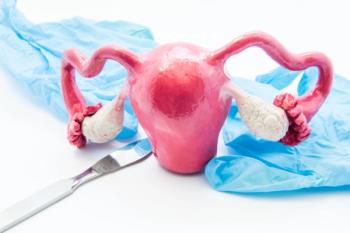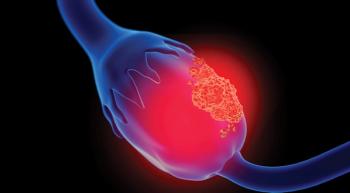
Ovarian Cancer: Initial Conversations About Surgery
Transcript:
Angeles Alvarez Secord, MD: Do you remember when we talked in the clinic about what the next step was in terms of surgery and how we make decisions?
Michelle Berke: Yes.
Angeles Alvarez Secord, MD: Our approach is a little different. There’s many different approaches you can have with ovarian cancer. Some people do primary debulking surgery followed by chemotherapy. Others would do neoadjuvant chemotherapy followed by a surgery, in-between, followed by more chemotherapy. It really depends on patient characteristics as well as disease involvement.
Michelle Berke: OK.
Angeles Alvarez Secord, MD: I don’t know if you remember this, but you’re young, you’re healthy, and you thought you had ovarian cancer. So, we talked about doing laparoscopy, first, to determine if we could remove all of the disease.
Michelle Berke: I remember that.
Angeles Alvarez Secord, MD: You were having so many symptoms. You were really uncomfortable.
Michelle Berke: Very uncomfortable, yes.
Angeles Alvarez Secord, MD: I felt like it would be worthwhile to move forward with surgery. So, we did the initial laparoscopy. At the time of the surgery, we did FIGO scoring. You probably don’t remember that, which is OK.
Michelle Berke: I don’t. I was so out of it back then.
Angeles Alvarez Secord, MD: That’s OK. We use a certain scoring method. If it’s a certain score, we say, “Hey, we can probably get all of this cancer out. Let’s go ahead and go for it.” Or, if it’s a bigger score, then we know we can’t remove all of the cancer. In this case, we do neoadjuvant chemotherapy.
In your case, I did something a little different. You were having so many symptoms from the mass and the tumor volume that we went ahead. I got that out as best as I could, but I knew I couldn’t get all of your cancer out to be R0.
Michelle Berke: Yes, I remember that.
Angeles Alvarez Secord, MD: And so, we finished, after that, with the thought that we would do IV chemotherapy with bevacizumab, to try to shrink down the cancer as much as possible.
Michelle Berke: Isn’t that Avastin?
Angeles Alvarez Secord, MD: Yes.
Michelle Berke: OK.
Angeles Alvarez Secord, MD: Then, a few cycles later, we did the bigger surgery with the intent of removing the rest of your cancer. And then, we did the belly wash therapy.
Michelle Berke: Yes, the intraperitoneal (IP) chemotherapy. I remember that. They had to roll me.
Angeles Alvarez Secord, MD: What did you think about belly wash therapy compared to the IV chemotherapy, only?
Michelle Berke: Well, the IV therapy was much easier, believe it or not. The IP, I was just a little squeamish with a port, I guess.
Angeles Alvarez Secord, MD: Right, but you got through it.
Michelle Berke: I did get through it. Yes.
Angeles Alvarez Secord, MD: But, it’s hard.
Michelle Berke: Yes. For first-line, standard treatment, I thought that was a really good call on your part.
Angeles Alvarez Secord, MD: That’s how we’re training everybody. We were really aggressive with intraperitoneal therapy. There have been so many studies supporting that approach, demonstrating prolonged survival and disease control. And then, just a year ago, they presented the new results on belly wash therapy, saying that if you combine chemotherapy, and there’s all of these different chemotherapy options with bevacizumab, there was no difference in survival between the groups. But more toxicity. And you lived through this, so you knew that.
Michelle Berke: Yes, I did.
Angeles Alvarez Secord, MD: And so, at this time, we have moved away from that belly wash therapy. We’re waiting for some more information. We are waiting for the GOG 252 trial results.
Michelle Berke: OK.
Angeles Alvarez Secord, MD: We’re waiting for that study to get completed so we know more about the survival outcomes. So, with ovarian cancer treatment, there’s no one way, right?
Michelle Berke: There’s so many different treatments out there. You just don’t know which one to pick.
Angeles Alvarez Secord, MD: And I’m sure that as a patient that was very confusing?
Michelle Berke: It was very confusing because, first of all, I’ve never had cancer before. This was all new to me. They explain all of these different treatments, and I wasn’t sure which one would be best for me. But you made good decisions on that part.
Angeles Alvarez Secord, MD: Thank you. So, after you finished the IP therapy, one of the big things we talked about was, should we keep going with the bevacizumab for maintenance? You were pretty tired at that point.
One of the things I talked about with you, Michelle, I realized I hadn’t even explained this better, was going back to the decision about proceeding with surgery or no surgery. I talked about R0. Many people are honestly thinking, “What on earth is R0?”
Michelle Berke: That’s what I was thinking. What is R0?
Angeles Alvarez Secord, MD: I apologize for that. R0 basically denotes that you have no evidence of disease left. We removed it all. It is completely gone. There’s no evidence that we can see, with the naked eye, that there’s any disease left. Then, there are other numbers that you can add in there that denote the volume of residual disease that’s left if it’s not R0. So, that’s the definition of R0.
Michelle Berke: OK.
Angeles Alvarez Secord, MD: So, you’re done with your chemotherapy. You have no evidence of disease. You did do maintenance bevacizumab, but for a short period of time. I think you just got tired and wanted to come off therapy? How hard of a decision was that for you?
Michelle Berke: It was hard. At the time, I didn’t know of the other options I had out there. So, if you’re giving up on one treatment, and then opting for another treatment, you need to get your knowledge together. You need to know if that’s the right treatment for you.
Angeles Alvarez Secord, MD: And in that case, we did surveillance. We did watchful waiting. Did you find that period of time, where you were not on treatment, to be more freeing? You were able to do the things you wanted and didn’t have to see me. Or were you more anxious?
Michelle Berke: I was more anxious. I felt like I wasn’t being proactive. I was just waiting. So, I feel better when I’m on treatment because I know that I’m being proactive. I’m doing something.
Angeles Alvarez Secord, MD: That’s really interesting. I think it points to the fact that you need to have that discussion. It’s not a one-size-fits all, is it?
It’s really individualized. You may feel a certain way. Somebody else feels a different way.
Michelle Berke: Yes. Every treatment is different. Every individual is different.
Transcript Edited for Clarity




